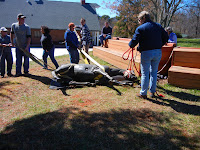Equine Rescue: I didn't know horses can do that!
Seeing a horse stuck in a hazardous situation can be both frightening and perplexing. If you know what to do, or what to expect, it can ease the trauma for both you and your horse.When we think of horsemanship, we think of the basic skills of riding, grooming and general care of the horse. Very few horse owners get a chance to learn how to safely rescue and remove a horse from a situation that makes you scratch your head and say; "I didn't know horses can do that!" I urge every horse owner, horse lover and equine professional to attend an educational clinic such as this.
Thanks to PEER, our local equine emergency rescue team, located in Polk Co. NC, horse owners, horse lover and equine professionals were given an opportunity, on March 12th 2013, to attend a training program given by Roger Lauze at FENCE. Roger is the Equine Rescue and Training coordinator for the MSPCA at Nevins Farm in Mass.
Participants worked with "Lucky" the mechanical horse, for a hands on with rescue equipment and proper handling techniques.
Some of the equipment used: very long, heavy duty cotton ropes, hobbles, twist type karabiners, ratchet straps, eye covering, rescue hook and the "Glide". A very important piece of equipment that made moving a 1,000+ lb. animal fairly easy. There were two "Glides" on site. One for manipulating a horses' body out of a tight situation and one designed to slide far up into a trailer to accommodate the center support bar that connects the two chest bars of a trailer. The horses' head rests to one side.
Some highlights of this educational clinic: Asses the situation and have a plan. Get vet on site to do what is necessary to calm the horse or immobilize him with the necessary drugs. The vet will also evaluate the seriousness of the situation. Control the crowd if there is one. Remaining calm and quiet is necessary for the rescue team to communicate and get the job done. Designating the team leader. The team leader will position each person to their designated post. Be it at the head of the horse, the rear of the horse, mid section of the horse, just to name a few. Each person is responsible for that section and to communicate to the rest of the team when it is ready and safe for the horse to be moved after he has been safely secured.
The participants broke off into two teams. Each team setting up a scenario of a horse trapped and the other team had to remove "Lucky" from his peril! They all were very creative. I hope no one has to experience any of these.

For the light of heart, when seeing this large majestic animal, trussed up somewhat like a turkey on a holiday dinner table, it may seem precarious looking. I can assure you, when the rescue team follows all the steps necessary to the letter, this neat little package can be moved just about anywhere, safely!
So if you ever come upon an Equine Rescue group, doing its job, please be mindful, stay out of their way. If they ask for help and you want to do so, do exactly what they tell you. Also support your local large animal rescue group in your area.








